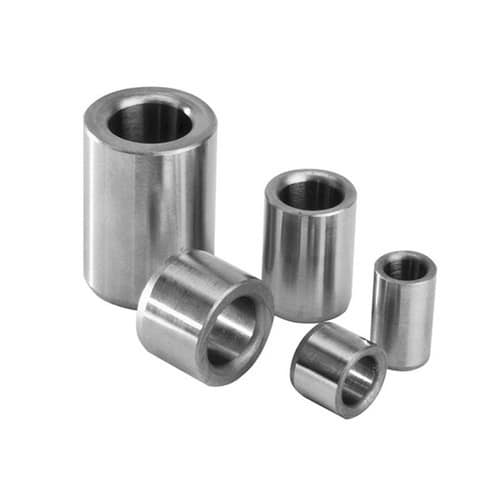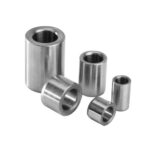5 Types of Bushings Used in Manufacturing

What is bushing?
A plain bearing, also known as a bushing, is a mechanical element used to reduce friction between rotating shafts and stationary support members.
Typically, a bushing relies on soft metal or plastic and an oil film to support the rotating shaft on the hardened shaft journal. Bushings (plain bearings) are distinguished from rolling-element bearings primarily by the fact that they consist of only one part.
That one part may be built up of different materials, layered and combined into a load carrying system. Depending on the application, bushings are available for operation with supplemental lubrication or to run “dry”, with no additional lubrication.
Some are made of relatively soft metal, such as Babbit, to protect the shaft journals. They are made of other materials as well, depending on the application and load requirements. Other bushings may be used for alignment jigs in drilling operations.
Let’s talk about its different types
- Metallic bushings
Metallic bushing materials consist of high strength metal backing embedded with solid lubricants. The metal provides high load capacity and the solid lubricants provide low friction during operation.
These bushings are precision machined with tighter tolerance to provide accurate fits after installation. This bearing design provides high load carrying capacity, good fatigue properties, dimensional stability, and improved thermal conductivity.
Tighter tolerance control can be achieved by re-machining the assembled bearing.
- Self-lubricating bushing
Self-lubricating bushingsare used where the bearing must operate without lubricant or with marginal lubricant. Our focus is on ensuring that the bearing gives the best performance and the longest life under various conditions.
The working principle of self-lubricating bushings is that, during the initial run-in period of the bearing, there will be a solid lubricating film created by the transfer of a small amount of material from the bearing layer.
This film directly contacts the moving parts, protecting and lubricating the mating components and extending the service life of the bearing.
- Bronze wrapped bushings
Bronze is a versatile and commonly used material for bushings because it comes in many alloys and compositions. Bronze sleeve bushings or bronze bearings are hard and strong, as opposed to brass bushings, which are softer and more easily deform.
Thus, bronze bushings have longer lifespans than brass bushing sleeves.
- Drill jig bushings
Drill jig bushings provide drill guidance during precision metal drilling operations and are ordinarily available as press-fit single parts or as two-piece renewable components that use replaceable liners.
Bushings of this kind serve more for guidance than support and are often made from harder steels than bushings designed to function as bearings.
They are usually very tightly toleranced to maintain the accuracy needed for machining operations.
- Bi-metallic bushings
Bi-metal bushings are composed of two metal strips, in two different materials; the first is normally in steel, the second is normally constituted by an alloy containing copper, which when coupled with the steel strip acts as an internal covering.
Furthermore, some sizes also have an external re-lubrication hole.
Summary
These bushings help you in getting the desired results when it is about the manufacturing of vehicles. They are an integral part of the manufacturing industry.
0

